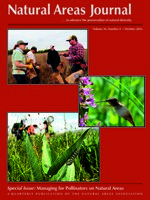Pollinators, such as butterflies, contribute to vital ecosystem services, but are susceptible to changing thermal regimes associated with recent climate change. While butterflies are responding to climate changes in many ways, they are not keeping pace. Rapid climate changes are leading to an accumulation of climate debts (or loss of climatic habitat) at continental scales. Climate change mediated shifts in distribution depend on many factors, but particularly on species-specific dispersal abilities and availability of larval host plants. We measured geographical variation in mobility for butterfly species across North America relative to their conservation status and the intensity of human land use. We identified areas where the rate and variability of recent climatic changes have been relatively low and could be managed for pollinator conservation, potentially augmenting existing protected area networks. Using the Yellowstone to Yukon region as a case study, we outline differences between connectivity analyses that incorporate (i) human footprint, (ii) human footprint in conjunction with climate change considerations, and (iii) human footprint in conjunction with climate change considerations weighted by species mobility and richness. All three approaches yield different connectivity recommendations. Conservation management efforts to enhance climate change-related dispersal should focus on improving landscape connectivity based on species-specific mobility, richness, and climate change, as well as landscape permeability. Improving connectivity is particularly vital in areas where mobility and landscape permeability are low but species are at greatest risk of extinction. Mobility matters when considering efforts to mitigate climate change impacts on butterflies.
How to translate text using browser tools
1 October 2016
Dispersal Limitation, Climate Change, and Practical Tools for Butterfly Conservation in Intensively Used Landscapes
Laura E. Coristine,
Peter Soroye,
Rosana Nobre Soares,
Cassandra Robillard,
Jeremy T. Kerr
ACCESS THE FULL ARTICLE

Natural Areas Journal
Vol. 36 • No. 4
Oct 2016
Vol. 36 • No. 4
Oct 2016
butterflies
climate change
connectivity
ecological services
host plant interactions




